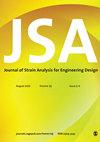Validation of a structural model of an aircraft cockpit panel: An industrial case study
IF 1.8
4区 工程技术
Q3 ENGINEERING, MECHANICAL
Journal of Strain Analysis for Engineering Design
Pub Date : 2021-11-19
DOI:10.1177/03093247211059084
引用次数: 3
Abstract
Computational models of structures are widely used to inform decisions about design, maintenance and operational life of engineering infrastructure, including airplanes. Confidence in the predictions from models is provided via validation processes that assess the extent to which predictions represent the real world, where the real world is often characterised by measurements made in experiments of varying sophistication dependent on the importance of the decision that the predictions will inform. There has been steady progress in developing validation processes that compare fields of predictions and measurements in a quantitative manner using the uncertainty in measurements as a basis for assessing the importance of differences between the fields of data. In this case study, three recent advances in a validation process, which was evaluated in an inter-laboratory study 5 years ago, are implemented using a ground-test on a fuselage at the aircraft manufacturer’s site for the first time. The results show that the advances successfully address the issues raised by the inter-laboratory study, that the enhanced validation process can be implemented in an industrial environment on a complex structure, and that the model was an excellent representation of the measurements made using digital image correlation.飞机座舱面板结构模型的验证:工业案例研究
结构的计算模型被广泛应用于工程基础设施(包括飞机)的设计、维护和使用寿命决策。对模型预测的信心是通过验证过程来提供的,该过程评估预测在多大程度上代表了现实世界,而现实世界的特征通常是在实验中进行的不同复杂程度的测量,这取决于预测将提供的决策的重要性。在开发以定量方式比较预测领域和测量领域的验证过程方面取得了稳步进展,利用测量中的不确定性作为评估数据领域之间差异重要性的基础。在本案例研究中,验证过程中的三个最新进展(在5年前的实验室间研究中进行了评估)首次在飞机制造商现场的机身上进行了地面测试。结果表明,这些进展成功地解决了实验室间研究提出的问题,增强的验证过程可以在复杂结构的工业环境中实施,并且该模型很好地代表了使用数字图像相关进行的测量。
本文章由计算机程序翻译,如有差异,请以英文原文为准。
求助全文
约1分钟内获得全文
求助全文
来源期刊

Journal of Strain Analysis for Engineering Design
工程技术-材料科学:表征与测试
CiteScore
3.50
自引率
6.20%
发文量
25
审稿时长
>12 weeks
期刊介绍:
The Journal of Strain Analysis for Engineering Design provides a forum for work relating to the measurement and analysis of strain that is appropriate to engineering design and practice.
"Since launching in 1965, The Journal of Strain Analysis has been a collegiate effort, dedicated to providing exemplary service to our authors. We welcome contributions related to analytical, experimental, and numerical techniques for the analysis and/or measurement of stress and/or strain, or studies of relevant material properties and failure modes. Our international Editorial Board contains experts in all of these fields and is keen to encourage papers on novel techniques and innovative applications." Professor Eann Patterson - University of Liverpool, UK
This journal is a member of the Committee on Publication Ethics (COPE).
 求助内容:
求助内容: 应助结果提醒方式:
应助结果提醒方式:


